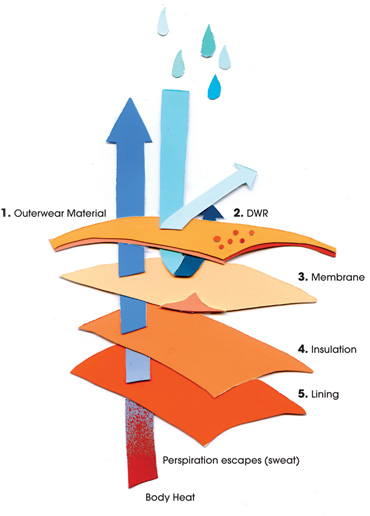How do you know if a garment is waterproof? Waterproof Ratings explained!

In a day and age where everything is rated and tested, waterproof ratings for clothing are one of those ratings many of us don’t properly understand. It is often thought if the item says its ‘waterproof’ you won’t get damp, no matter how strong the downpour! However, modern waterproof garments and ratings are a bit more complicated than this, as many are breathable, as well as waterproof.

How waterproof garments are rated
The test most commonly used to see how waterproof a garment actually is is known as the Static-column test. A tube stands vertically over the material being tested, and then the tube is filled with water. The level of water in millimeters when water begins to leak through the material becomes the waterproof rating. For example, material that doesn’t leak until 6000mm of water is inside the tube has a rating of 6000mm, or is considered ‘rainproof’. Refer to the table below for the standard waterproof ratings and their descriptions!
Garment waterproofing ratings
| Waterproof Rating (mm) | Water Resistance Provided | Conditions |
| 0-5,000 mm | No resistance to some resistance to moisture. | Light rain, dry snow, no pressure. |
| 6,000-10,000 mm | Rainproof and waterproof under light pressure. | Light rain, average snow, light pressure. |
| 11,000-15,000 mm | Rainproof and waterproof except under high pressure. | Moderate rain, average snow, light pressure. |
| 16,000-20,000 mm | Rainproof and waterproof under high pressure. | Heavy rain, wet snow, some pressure. |
| 20,000 mm+ | Rainproof and waterproof under very high pressure. | Heavy rain, wet snow, high pressure. |

How garment waterproofing works
How a garment is waterproofed can vary significantly from brand to brand, but the below image shows a popular combination of layers.
1 & 2. The outer layer, often known as the “face fabric”, is usually nylon or polyester and is often treated with a solution called Durable Water Repellent (DWR). The outer layer isn’t waterproof but the DWR coating means it won’t soak up water.
3. The membrane is the layer that keeps water out. The membrane is made up of tiny holes, too small to allow water to enter, but large enough to be breathable and allow moisture to exit/evaporate (more on this later). They are often coated with Polyurethane as well to protect them against oil and sweat.
4. This layer is optional and depends on the design of the jacket, but will generally capture air particles to insulate the wearer and trap their body heat.
5. The lining is for comfort and should be breathable and lightweight, which is why a popular option is mesh.
Depending on the level of waterproofing needed, taped seams may also be required, which will seal the stitching and stop moisture creeping through.
Breathable waterproof garments
As we’ve mentioned already, breathable waterproof garments are a modern development that will keep you even drier! While a traditional rain coat made from materials such as rubber won’t leak at all, after any physical activity the wearer will start perspiring, leaving them damp and cold anyway. Breathable waterproof garments, on the other hand, allow moisture to evaporate and will minimise perspiration, leaving you drier and more comfortable!
Final note: Re-waterproofing your garments with aftermarket DWR
After repeated use, washing and general wear and tear, your waterproof garments may begin leaking. Aftermarket DWR sprays are available and can be applied to your garment after a thorough wash and rinse. Spray on DWRs are recommended over wash in products, as these may mess with the membrane.






